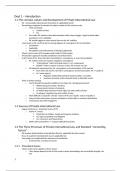Summary
PIL summary 2023—2024
- Course
- Institution
This is a summary of the Private International Law (PIL) course taught by Prof. Van Calster. The summary is based on the handbook. This is a summary of the course Private International Law (PIL), given by Prof. Van Calster. The summary is based on the course book.
[Show more]



